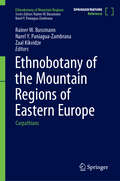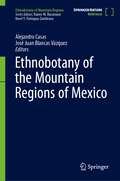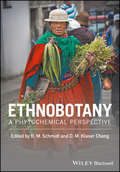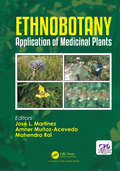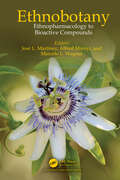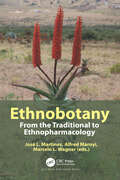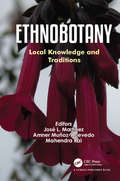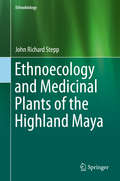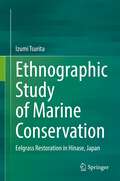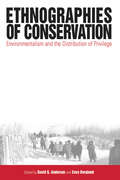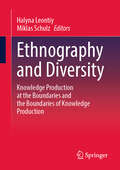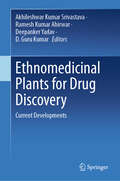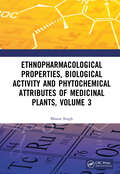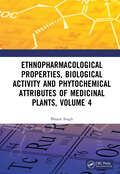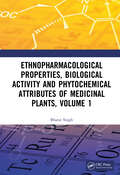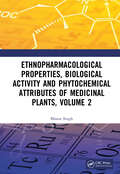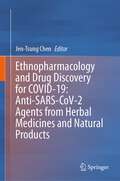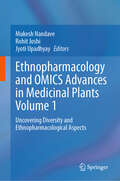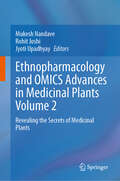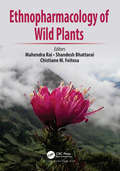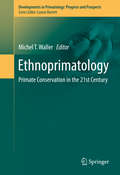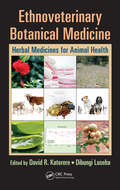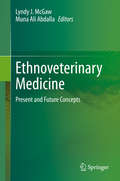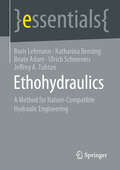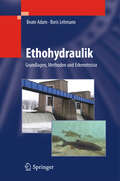- Table View
- List View
Ethnobotany of the Mountain Regions of Eastern Europe: Carpathians (Ethnobotany of Mountain Regions)
by Rainer W. Bussmann Zaal Kikvidze Narel Y. Paniagua-ZambranaNatural resources and associated biological diversity provide the basis of livelihood for humans, particularly in the rural areas and mountain regions around the world. Over centuries, indigenous peoples, traditional societies, and local communities have developed their own specific knowledge regarding plant use, management, and conservation. The history of plant use by humans as food and to treat diverse ailments dates back to ancient civilizations. Even though the advent of allopathic medicine has somehow minimized the role of medicinal plants in favor of synthetic drugs, a number of modern drug discoveries have been based on medicinal plants used by indigenous peoples. Ethnobiology is the burgeoning interdisciplinary scientific field, which covers all types of interactions between plants and people, and Eastern Europe is recognized as a plant diversity hot spot. This new Major Reference Work on the Ethnobotany of Mountain Regions of Eastern Europe: Carpathians covers in detail the mountains and vallies of this region, which are known to be rich in unique medicinal and food plant species. Local communities residing in the mountain regions of Eastern Europe possess unique knowledge of surrounding resources, which is the result of many years of interaction with and selection of the most desirable and pervasive plant species present. In this context this major reference work provides comprehensive information on cross-culture variation in the traditional uses of plants as food, medicine, and for cultural purposes among these diverse communities residing in Eastern Europe. The key areas of focus include plant diversity in the Carpathians, cross cultural variation in traditional uses of plant species by these communities, high-value medicinal and food plant species, and threats and conservation status of plant species and traditional knowledge.
Ethnobotany of the Mountain Regions of Mexico (Ethnobotany of Mountain Regions)
by Alejandro Casas José Juan Blancas VázquezResearch in recent years has increasingly shifted away from purely academic research, and into applied aspects of the discipline, including climate change research, conservation, and sustainable development. It has by now widely been recognized that “traditional” knowledge is always in flux and adapting to a quickly changing environment. Trends of globalization, especially the globalization of plant markets, have greatly influenced how plant resources are managed nowadays. While ethnobotanical studies are now available from many regions of the world, no comprehensive encyclopedic series focusing on the worlds mountain regions is available in the market. Scholars in plant sciences worldwide will be interested in this website and its dynamic content. The field (and thus the market) of ethnobotany and ethnopharmacology has grown considerably in recent years. Student interest is on the rise, attendance at professional conferences has grown steadily, and the number of professionals calling themselves ethnobotanists has increased significantly (the various societies (Society for Economic Botany, International Society of Ethnopharmacology, Society of Ethnobiology, International Society for Ethnobiology, and many regional and national societies in the field currently have thousands of members). Growth has been most robust in BRIC countries.The objective of this new MRW on Ethnobotany of Mountain Regions is to take advantage of the increasing international interest and scholarship in the field of mountain research. We anticipate including the best and latest research on a full range of descriptive, methodological, theoretical, and applied research on the most important plants for each region. Each contribution will be scientifically rigorous and contribute to the overall field of study.
Ethnobotany: A Phytochemical Perspective
by Barbara M. Schmidt Diana M. Klaser ChengEthnobotany: A Phytochemical Perspective explores the chemistry behind hundreds of plant medicines, dyes, fibers, flavors, poisons, insect repellants, and many other uses of botanicals. Bridging the gap between ethnobotany and chemistry, this book presents an introduction to botany, ethnobotany, and phytochemistry to clearly join these fields of study and highlight their importance in the discovery of botanical uses in modern industry and research. Part I. Ethnobotany, explores the history of plant exploration, current issues such as conservation and intellectual property rights, and a review of plant anatomy. An extensive section on plant taxonomy highlights particularly influential and economically important plants from across the plant kingdom. Part II. Phytochemistry, provides fundamentals of secondary metabolism, includes line drawings of biosynthetic pathways and chemical structures, and describes traditional and modern methods of plant extraction and analysis. The last section is devoted to the history of native plants and people and case studies on plants that changed the course of human history from five geographical regions: Africa, the Americas, Asia, Europe, and Ocean. Throughout the entire book, vivid color photographs bring science to life, capturing the essence of human botanical knowledge and the beauty of the plant kingdom.
Ethnobotany: Application of Medicinal Plants
by Mahendra Rai José L. Martinez Amner Muñoz-AcevedoEthnobotany includes the traditional use of plants in different fields like medicine and agriculture. This book incorporates important studies based on ethnobotany of different geographic zones. The book covers medicinaland aromatic plants, ethnopharmacology, bioactive molecules, plants used in cancer, hypertension, disorders of the central nervous system, and also as antipsoriatic, antibacterial, antioxidant, antiurolithiatic. The book will be useful for a diverse group of readers including plant scientists, pharmacologists, clinicians, herbalists, natural therapy experts, chemists, microbiologists, NGOs and those who are interested in traditional therapies.
Ethnobotany: Ethnopharmacology to Bioactive Compounds
by José L. Martinez Alfred Maroyi Marcelo L. WagnerEthnobotany: Ethnopharmacology to Bioactive Compounds comprises of carefully selected studies focusing on the importance of ethnobotanical data as an effective approach towards the discovery of novel ethnopharmacological properties and bioactive compounds that characterize herbal products, pharmaceutical drugs and medicinal plants. This book incorporates therapeutic, nutritional, phytochemistry and pharmacological properties of medicinal plants, mechanisms of action and clinical trials of bioactive compounds as well as the molecular basis of the bioactive compounds from the perspective of modern phytochemistry. This book will be useful for a diverse group of readers including students, botanists, pharmacists, chemists, herbalists and those researchers interested in ethnobotany and ethnopharmacology.
Ethnobotany: From the Traditional to Ethnopharmacology
by José L. Martinez Alfred Maroyi Marcelo L. WagnerIn this book we present recent studies that have been carried out on some widely used medicinal plants. The need for new and alternative treatments stem from the lack of efficiency of existing remedies for certain illnesses. We have compiled information that may be useful to researchers in their quest to develop new drugs.
Ethnobotany: Local Knowledge and Traditions
by Mahendra Rai Jose L. Martinez Amner Munoz-AcevedoEthnobotany: Local Knowledge and Traditions discusses various plants that have actually been used in traditional medicine for a specific ailment. It desribes the biological effectiveness (activities) related to each "sickness" which have been scientifically verified. This book will also discuss the bioactivities established/determined that are promising and have potential. Finally, this book will be an appropriate consultation tool for scientists/professionals/experts such as ethnobotanists, botanists, cell/molecular biologists, chemists, pharmacists, pharmacologists, environmentalists/ecologists.
Ethnoecology and Medicinal Plants of the Highland Maya (Ethnobiology Ser.)
by John Richard SteppPlants play a central role in human existence. Medicinal plants, in particular, have allowed for the continued survival of the human species. This book, based on over a decade of research in Southern Mexico with the Highland Maya, explores the relationship between medicinal plants, traditional ecological knowledge and the environment. The biodiversity of the region remains among the highest in the world, comprising more than 9000 plant species. Over 1600 employed for medicinal uses and knowledge for approximately 600 species is widespread. Medicinal plants play an overwhelmingly primary role in the daily health care of the Highland Maya. Three principal objectives are addressed: 1) identifying which medicinal plants are used; 2) determining the role of environmental variation on use and selection of medicinal plants; and 3) identifying which habitats are preferred for medicinal plant procurement. Findings demonstrate the overwhelming importance of human modified environments for medicinal plants. Explanations are presented from human ecology and biochemical ecology. Implications for conservation, health and the environment are discussed.
Ethnographic Study of Marine Conservation: Eelgrass Restoration in Hinase, Japan
by Izumi TsuritaThis book explores the nature of marine conservation based on the case study of Hinase, a fishing village in Okayama, Japan. It focuses on the fishers’ self-motivated eelgrass restoration activity which has been continued for more than 30 years. This activity in Hinase recently attracted international attention as a case under the name “Satoumi” and “Marine Protected Areas” in several governmental reports, but detailed information, such as the historical background and social structure of Hinase, has not yet been analyzed. This book, therefore, fulfills this gap by providing its ethnographic information. In addition, this book offers some points for critical thinking by concluding that marine conservation activities cannot always be evaluated or arranged under the standardized approach with limited time and space. This viewpoint reaffirms the importance of local initiative and highlights the value of qualitative research to seek the way forward for promising marine conservation. This book is suitable for an academic audience in the field of social sciences, such as applied anthropology, as well as ecologists, government officials, environmentalists, and citizens who are interested or engaged in environmental issues or natural resource management.
Ethnographies Of Conservation
by David G. AndersonAnthropologists know that conservation often disempowers already under-privileged groups, and that it also fails to protect environments. Through a series of ethnographic studies, this book argues that the real problem is not the disappearance of "pristine nature" or even the land-use practices of uneducated people. Rather, what we know about culturally determined patterns of consumption, production and unequal distribution, suggests that critical attention would be better turned on discourses of "primitiveness" and "pristine nature" so prevalent within conservation ideology, and on the historically formed power and exchange relationships that they help perpetuate.
Ethnography and Diversity: Knowledge Production at the Boundaries and the Boundaries of Knowledge Production
by Halyna Leontiy Miklas SchulzThe focus of the volume is on ethnographically oriented research practice. It is reflected in the mirror of the currently controversial concepts of diversity and intersectionality in the cultural and social sciences. Special attention is paid to the question of how researchers deal with the methodological problem of the production, reproduction and reflection of categories. Which categories are already brought to the 'field', later revised or solidified, and which categories finally accompany the interpretation process and which constitute the presentation of results? How and why do they emerge? And last but not least: How are specific worlds of experience of human diversity co-produced or transformed by (research) categories? The Content Conceptual foundations - Diversity and inclusion in educational contexts - Interculture in diversity - Diversity in the field of tension between body, gender and disability The Editors Dr. rer. soc. Halyna Leontiy is Substitute Professor (Verwaltungsprofessorin) of Foundations of Social Sciences, Institute of Methods and Methodological Principles in the Social Sciences (IMMS), University of Goettingen, Germany since October 2021. Prof. Dr. phil. Miklas Schulz is a visiting researcher focusing on Inclusive Education and School Development at the Institute of Educational Science, Department of Applied Educational Science, at the University of Hildesheim.
Ethnomedicinal Plants for Drug Discovery: Current Developments
by Akhileshwar Kumar Srivastava Ramesh Kumar Ahirwar Deepanker Yadav D. Guru KumarThis book explains the translational aspects of ethnomedicinal plants of different geographical regions including India by explaining the medicinal properties against several diseases, genomic evolution in changing environments, metabolic profiling for biomarker discovery, the role of non-coding RNA in the synthesis of secondary metabolites, genome-wide transcriptome profiling, application of pluripotent stem cells for drug discovery, the importance of high-throughput omics, and genome-editing techniques. In addition, some of the chapters have been designed to describe the role of artificial intelligence, plant database, and network-based drug discovery to explore the medicinal importance of compounds as well as challenges and opportunities in drug discovery from ethnomedicinal plants. The book serves as a great source of information for the students, researchers/scientists of diverse fields such as pharmacognosy, plant physiologists, biotechnologists, and pharmaceutical scientists etc., working in the areas of phytotherapy from ethnomedicinal plants.
Ethnopharmacological Properties, Biological Activity and Phytochemical Attributes of Medicinal Plants Volume 3
by Bharat SinghThis book covers the morphological characteristics, ethnopharmacological properties, isolated and identified structurally diverse secondary metabolites, biological and pharmacological activities of medicinal plants. Ethnopharmacology is the systematic study of folklore/traditional medicines, which continue to provide innovative drugs and lead molecules for the pharmaceutical industry. In fact, plant secondary metabolites, used as a single molecule or as a mixture, are medicines that can be effective and safe even when synthetic drugs fail. Therefore, the description of these secondary metabolites as well as methods for the targeted expression and/or purification is of high interest. In addition to surveying the morphological features, ethnopharmacological properties, biological and pharmacological activities, and studies of clinical trials, this book offers a comprehensive treatment of 56 plant species. It also presents the cell culture conditions and various methods used for increasing the production of medicinally important secondary metabolites in plant cell cultures. This volume: · Provides the morphological features, habitat, and distribution of each species of 56 genera selected from the different regions of the world. · Presents ethnopharmacological applications of various species of included 56 genera of this book. Different species of 56 genera are used for ethnomedicinal uses by the people of various countries of the world. · Describes structures of various secondary metabolites identified in 56 plant species together with their biological and pharmacological activities. · Discusses strategies of secondary metabolites production, such as organ culture, pH, elicitation, hairy root cultures, light, and mutagenesis. · Provides a complete overview of each species of 56 genera and complete information up to year 2022. Ethnopharmacological Properties, Biological Activity and Phytochemical Attributes of Medicinal Plants is an important book for undergraduate and postgraduate students, pharmacologists, phytochemists, Ayurvedic practitioners, medical doctors, and biotechnologists interested in the ethnopharmacological properties, phytochemistry, and biological and pharmacological activities of plants.
Ethnopharmacological Properties, Biological Activity and Phytochemical Attributes of Medicinal Plants Volume 4
by Bharat SinghThis book covers the morphological characteristics, ethnopharmacological properties, isolated and identified structurally diverse secondary metabolites, biological and pharmacological activities of medicinal plants. Ethnopharmacology is the systematic study of folklore/traditional medicines, which continue to provide innovative drugs and lead molecules for the pharmaceutical industry. In fact, plant secondary metabolites, used as a single molecule or as a mixture, are medicines that can be effective and safe even when synthetic drugs fail. Therefore, the description of these secondary metabolites as well as methods for the targeted expression and/or purification is of high interest. In addition to surveying the morphological features, ethnopharmacological properties, biological and pharmacological activities, and studies of clinical trials, this book offers a comprehensive treatment of 56 plant species. It also presents the cell culture conditions and various methods used for increasing the production of medicinally important secondary metabolites in plant cell cultures. This volume: Provides the morphological features, habitat, and distribution of each species of 56 genera selected from the different regions of the world. Presents ethnopharmacological applications of various species of the 56 genera in this book. Different species of 56 genera are used for ethnomedicinal uses by the people of various countries of the world. Describes structures of various secondary metabolites identified in 56 plant species together with their biological and pharmacological activities. Discusses strategies of secondary metabolites production, such as organ culture, pH, elicitation, hairy root cultures, light, and mutagenesis. Provides a complete overview of each species of 56 genera and the complete information up to 2022. Ethnopharmacological Properties, Biological Activity and Phytochemical Attributes of Medicinal Plants is an important book for undergraduate and postgraduate students, pharmacologists, phytochemists, Ayurvedic practitioners, medical doctors, and biotechnologists interested in the ethnopharmacological properties, phytochemistry, biological, and pharmacological activities of plants.
Ethnopharmacological Properties, Biological Activity and Phytochemical Attributes of Medicinal Plants, Volume 1
by Bharat SinghThis book covers the morphological characteristics, ethnopharmacological properties, isolated and identified structurally diverse secondary metabolites, biological and pharmacological activities of medicinal plants. Ethnopharmacology is the systematic study of folklore/traditional medicines, which continue to provide innovative drugs and lead molecules for the pharmaceutical industry. In fact, plant secondary metabolites, used as a single molecule or as a mixture, are medicines that can be effective and safe even when synthetic drugs fail. Therefore, the description of these secondary metabolites as well as methods for the targeted expression and/or purification is of high interest. In addition to surveying the morphological features, ethnopharmacological properties, biological and pharmacological activities, and studies of clinical trials, this book offers a comprehensive treatment of 56 plant species. It also presents the cell culture conditions and various methods used for increasing the production of medicinally important secondary metabolites in plant cell cultures. This volume: · Provides the morphological features, habitat, and distribution of each species of 56 genera selected from the different regions of the world. · Presents ethnopharmacological applications of various species of the 56 genera included in this book. Different species of 56 genera are used for ethnomedicinal uses by the people of various countries of the world. · Describes structures of various secondary metabolites identified in 56 plant species together with their biological and pharmacological activities. · Discusses strategies of secondary metabolites production, such as organ culture, pH, elicitation, hairy root cultures, light, and mutagenesis. · Provides a complete overview of each species of 56 genera and complete information up to 2022. Ethnopharmacological Properties, Biological Activity and Phytochemical Attributes of Medicinal Plants is an important book for undergraduate and postgraduate students, pharmacologists, phytochemists, Ayurvedic practitioners, medical doctors, and biotechnologists interested in the ethnopharmacological properties, phytochemistry, and biological and pharmacological activities of plants.
Ethnopharmacological Properties, Biological Activity and Phytochemical Attributes of Medicinal Plants, Volume 2
by Bharat SinghThis book covers the morphological characteristics, ethnopharmacological properties, isolated and identified structurally diverse secondary metabolites, biological and pharmacological activities of medicinal plants. Ethnopharmacology is the systematic study of folklore/traditional medicines, which continue to provide innovative drugs and lead molecules for the pharmaceutical industry. In fact, plant secondary metabolites, used as a single molecule or as a mixture, are medicines that can be effective and safe even when synthetic drugs fail. Therefore, the description of these secondary metabolites as well as methods for the targeted expression and/or purification is of high interest. In addition to surveying the morphological features, ethnopharmacological properties, biological and pharmacological activities, and studies of clinical trials, this book offers a comprehensive treatment of 56 plant species. It also presents the cell culture conditions and various methods used for increasing the production of medicinally important secondary metabolites in plant cell cultures. This volume: · Provides the morphological features, habitat, and distribution of each species of 56 genera selected from the different regions of the world. · Presents ethnopharmacological applications of various species of the 56 genera included in this book. Different species of 56 genera are used for ethnomedicinal uses by the people of various countries of the world. · Describes structures of various secondary metabolites identified in 56 plant species together with their biological and pharmacological activities. · Discusses strategies of secondary metabolites production, such as organ culture, pH, elicitation, hairy root cultures, light, and mutagenesis. · Provides a complete overview of each species of 56 genera and complete information up to 2022. Ethnopharmacological Properties, Biological Activity and Phytochemical Attributes of Medicinal Plants is an important book for undergraduate and postgraduate students, pharmacologists, phytochemists, Ayurvedic practitioners, medical doctors, and biotechnologists interested in the ethnopharmacological properties, phytochemistry, and biological and pharmacological activities of plants.
Ethnopharmacology and Drug Discovery for COVID-19: Anti-SARS-CoV-2 Agents from Herbal Medicines and Natural Products
by Jen-Tsung ChenThis book presents a complete overview of COVID-19 and provides a series of in-depth analyses of the literature and a comprehensive discussion and perspectives on promising anti-SARS-CoV-2 agents based on the system of ethnopharmacology, which covers Chinese medicine, traditional medicines of India and Africa, Turkish folk medicine, essential oils, and some well-known medicinal plants. In this book, the current status of therapeutic strategies against COVID-19 was summarized and a perspective of potential options for the future was proposed. Based on ethnopharmacology, some well-established traditional herbal formulations and bioactive compounds with anti-virus activity were repurposed for managing COVID-19 and post-illness, including neurological disorders and kidney illness. Using drug discovery tools, promising immune enhancers were explored from phytochemicals against SARS-CoV-2. Nutraceuticals from dietary plants, spices, and fruits with anti-virus and antioxidant activities were recommended to prevent infection or severe illness caused by emerging variants. With the aid of systems pharmacology, researchers have gained insights into possible molecular mechanisms of anti-SARS-CoV-2 activity and have predicted a range of candidate compounds from medicinal plants to combat COVID-19. This book explores the current knowledge of drug discovery and ethnopharmacology for managing coronavirus diseases. The content proved the anti-SARS-CoV-2 activity from natural products and traditional herbal medicines. It contributes to the management of global public health and fits the goal of establishing “Good Health and Well-Being,” which is one of “The Sustainable Development Goals (SDGs) 2030".
Ethnopharmacology and OMICS Advances in Medicinal Plants Volume 1: Uncovering Diversity and Ethnopharmacological Aspects
by Mukesh Nandave Rohit Joshi Jyoti UpadhyayThe book explores the world of medicinal plants through a groundbreaking and comprehensive book. It delves into high-throughput technologies and multi-omics approaches to unlock the untapped potential of endophytic fungi, revealing novel bioactive compounds. It further talks about the diverse biodiversity and ethnopharmacological knowledge, unravelling the molecular intricacies of secondary metabolites under varying ecological conditions. This gives insights into medicinal plant research, offering cutting-edge insights into genome-based barcoding, nanotechnology, and functional genomics for revolutionary drug discoveries. From proteomic and epigenomic analysis to big data exploration, this book presents a holistic view of medicinal plants' potential and discusses the latest advancements in micropropagation, agronomical approaches, and genome editing, paving the way for transformative medicines and healthcare breakthroughs.It serves as a great resource for academicians, researchers, and pharmacologists.
Ethnopharmacology and OMICS Advances in Medicinal Plants Volume 2: Revealing the Secrets of Medicinal Plants
by Mukesh Nandave Rohit Joshi Jyoti UpadhyayThis book delves into diverse facets and applications of medicinal plants. It discusses the metabolic, transcriptomic, and genomic intricacies of medicinal plants, shedding light on their chemical compositions, genetic makeup, and regulatory mechanisms. It includes a chapter on nanotechnology, investigating the influence of nanoparticles on medicinal plants. Subsequent chapters explore functional genomics and genome editing, showcasing innovative approaches to modifying plant genetics. It also discusses plant-associated microorganisms in the microbiome and endophytic fungi. Furthermore, the book addresses the critical issues of genetic diversity, agrotechnology for sustainable production, intellectual property rights, and the impact of various stresses on medicinal plants. This book serves as a valuable resource for researchers, educators, and students of pharmacology, offering a comprehensive understanding of medicinal plants and their evolving role in science and medicine.
Ethnopharmacology of Wild Plants
by Mahendra Rai; Shandesh Bhattarai; Chistiane M. FeitosaThe book provides valuable information on wild plants and their ethnopharmacological properties, discussion on ethnobotany, phytotherapy, diversity, chemical and pharmacological properties including antifungal, anti-inflammatory and antiprotozal properties. The chapters include a wide range of case studies, giving updated evidence on importance of wild plant resources from different countries including Nepal, India, Brazil, Chile, Argentina, Colombia, Egypt, Peru, etc. In addition, some specific species are used to explain their potential properties. Discussing traditional usage and pharmacological properties of wild plants, this book is entirely different from other related publications and useful for the researchers working in the areas of conservation biology, botany, ethnobiology, ethnopharmacology, policy making, etc.
Ethnoprimatology
by Michel T. WallerThe list of challenges facing nonhuman primates in the 21st century is a long one. The expansion of palm oil plantations to feed a growing consumer class is eating away at ape and monkey habitats in Southeast Asia and Central Africa. Lemurs are hunted for food in the poorest parts of Madagascar while monkeys are used as medicine in Brazil. Traditional cultural beliefs are maintaining demand for animal body parts in West African markets while viral YouTube videos of "cute" and "cuddly" lorises have increased their market value as pets and endangered their populations. These and other issues are addressed in this book by leading researchers in the field of ethnoprimatology, the study of human/nonhuman primate interactions that combines traditional primatological methodologies with cultural anthropology in an effort to better understand the nuances of our economic, ritualistic, and ecologic relationships.
Ethnoveterinary Botanical Medicine: Herbal Medicines for Animal Health
by David R. Katerere Dibungi LusebaDespite the undoubted success of a scientific approach to pharmaceuticals, the last few decades have witnessed a spectacular rise in interest in herbal medicinal products. This general interest has been followed by increasing scientific and commercial attention that led to the coining of the term ethnopharmacology to describe the scientific discipl
Ethnoveterinary Medicine: Present and Future Concepts
by Lyndy J. McGaw Muna Ali AbdallaThe importance of a complementary approach to animal health is highlighted in this book, with core themes encompassing reviews of traditional veterinary medicine for common diseases afflicting livestock, as well as local practices in different areas of the world. The book includes chapters on ethnoveterinary medicine used to prevent and treat ticks and tick-borne diseases, infectious diseases and parasites. Ethnoveterinary practices in parts of the world which have not been comprehensively reviewed before are highlighted, including Estonia, Belarus and the Maghreb - the north-western tip of Africa. A fascinating account of African ethnoveterinary medicine and traditional husbandry practices is provided by a veteran in the field with a wealth of practical experience in the area. Neglected areas of research involve the relationship of ethnoveterinary medicine with environmental, ethical, cultural and gender aspects, and leading experts explore these issues.The book is intended to provide an informative compilation of current research and future prospects in ethnoveterinary medicine, which hopes to inform and encourage investigations in new directions. Sustainable development requires a concerted effort to combine indigenous knowledge systems with scientific research to improve animal health. This is the case not only in rural areas where access to orthodox veterinary health care may be limited, but also against the backdrop of antibiotic resistance and increased demand for alternative and complementary therapies to enhance the health of both production and companion animals. Students, academics and veterinary professionals will find this book a useful addition to knowledge on present and future aspects of ethnoveterinary research.
Ethohydraulics: A Method for Nature-Compatible Hydraulic Engineering (essentials)
by Beate Adam Boris Lehmann Ulrich Schwevers Katharina Bensing Jeffrey A. TuhtanEthohydraulics is the transdiscipline linking behavioural science (ethology) and flow behaviour (hydraulics). Ethohydraulic studies provide repeatable and scalable insights into the reactive behaviour of aquatic animals. The findings can be used to derive limits and guidelines as well as design specifications for the planning of hydraulic engineering facilities. In this essential book, the authors provide an overview of the fundamentals and methodological approaches of ethohydraulic investigations. In addition to real-world case studies, current developments and future advances are provided.This Springer essential is a translation of the original German 1ststedition essentials,Ethohydraulik by Boris Lehmann, published by Springer-Verlag GmbH Germany, part of Springer Nature in 2021. The translation was done with the help of artificial intelligence (machine translation by the service DeepL.com). A subsequent human revision was done primarily in terms of content, so that the book will read stylistically differently from a conventional translation. Springer Nature works continuously to further the development of tools for the production of books and on the related technologies to support the authors.
Ethohydraulik
by Beate Adam Boris LehmannUm Fließgewässer den Nutzungsansprüchen des Menschen anzupassen, sind unzählige Baumaßnahmen erforderlich. Um die Auswirkungen wasserbaulicher Aktivitäten auf die in Fließgewässern lebenden Tiere zu untersuchen, wurde die Ethohydraulik entwickelt. Sie beruht auf der Ethologie (Erforschung des Verhaltens von Tieren) und der Hydraulik (Lehre von den bewegten Flüssigkeiten). Die Autoren stellen die Grundlagen dieser Wissenschaftsdisziplin dar und liefern Regeln sowie Grenz- und Bemessungswerte für die wasserbauliche Praxis.
